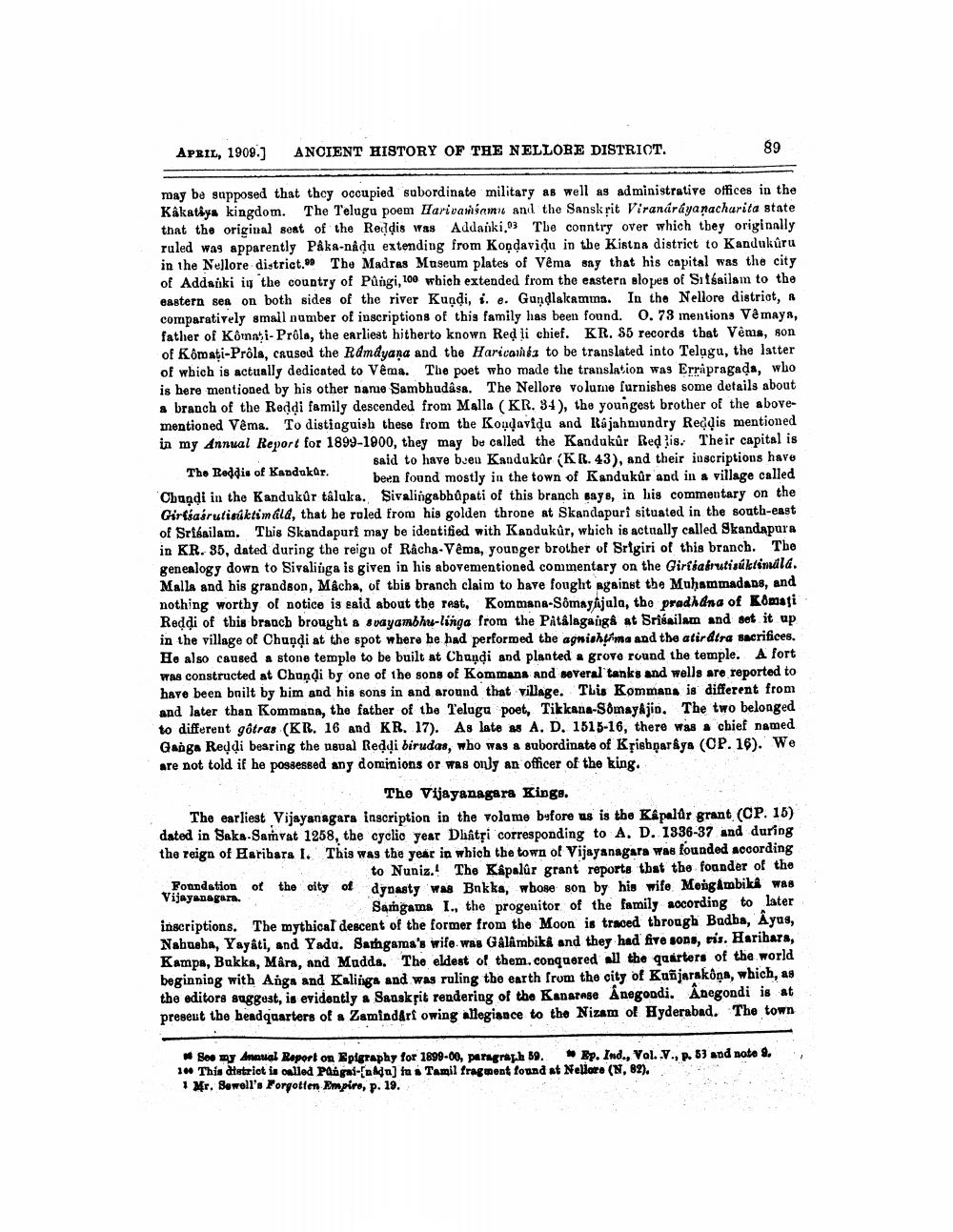________________
APRIL, 1909.)
ANCIENT HISTORY OF THE NELLORE DISTRICT.
89
may be supposed that they occupied subordinate military as well as administrative offices in the Kakatiya kingdom. The Telugu poem Harivamsamu and the Sanskrit Viranarayanacharita state that the original seat of the Reddis was Addanki.03 The conntry over which they originally ruled was apparently Påka-nadu extending from Koņdavidu in the Kistna district to Kandukuru in the Nellore district. The Madras Museum plates of Vêma say that his capital was the city of Addanki in the country of Pungi, 100 which extended from the eastern slopes of Sitsailam to the eastern sea on both sides of the river Kuņdi, s. e. Gundlakamina. In the Nellore district, R comparatively small number of inscriptions of this family has been found. 0.73 mentions Vêmaya, father of Kôni-Próla, the earliest hitherto known Red li chief. KR. 85 records that Vêms, son of Komati-Prôla, caused the Ramdyana and the Haricainda to be translated into Telugu, the latter of which is actually dedicated to Vêma. The poet who made the translation was Errapragada, who is here mentioned by his other nane Sambhudåse. The Nellore volume furnishes some details about a branch of the Reddi family descended from Malla (KR. 94), the youngest brother of the abovementioned Vêma. To distinguish these from the Kondavidu and Rajahmundry Reddis mentioned in my Annual Report for 1899-1900, they may be called the Kandukûr Red ?is. Their capital is
said to have buen Kandukûr (KR. 43), and their inscriptions have The Reddis of Kandukar.
been found mostly in the town of Kandukůr and in a village called Chuadi in the Kandukur tálaka. Sivalingabhûpati of this branch says, in his commentary on the Girfasrutisktimáld, that he roled from his golden throne at Skandapuri situated in the south-east of Srisailam. This Skandapuri may be identified with Kandukûr, which is actually called Skandapura in KR. 35, dated during the reign of Racha-Vêma, younger brother of Srigiri of this branch. The genealogy down to Sivalinga is given in his abovementioned commentary on the Girlsabrutisúktamála. Malla and his grandson, Mâcha, of this branch claim to have fought against the Muhammadans, and nothing worthy of notice is said about the rest. Kommana-Somayajala, the pradhana of Komaji Reddi of this branch brought a svayambhu-linga from the PAtalagangå at Srisailam and set it up in the village of Chundi at the spot where he had performed the agnishma and the atir dira sacrifices. He also caused a stone temple to be built at Chundi and planted a grove round the temple. A fort was constructed at Chuņdi by one of the sons of Kommans and several tanks and wells are reported to have been built by him and his sons in and around that village. This Kommana is different from and later than Kommana, the father of the Telugu poet, Tikkana-Somayajin. The two belonged to different gôtras (KR. 16 and KR. 17). As late as A. D. 1515-16, there was a chief named Ganga Reddi bearing the usual Reddi birudas, who was a subordinate of Krishqarkys (CP. 16). We are not told if he possessed any dominions or was only an officer of the king.
The Vijayanagara Kinga. The earliest Vijayanagara inscription in the rolame before us is the Kapalor grant (CP. 15) dated in Saka-Samvat 1258, the cyclio year Dhátři corresponding to A. D. 1836-37 and during the reign of Harihara I. This was the year in which the town of Vijayanagara was founded according
to Nuniz.! The Kapalûr grant reports that the founder of the Foundation of the city of dynasty WAS Bnkka. wbose son by his wifo Mongambika Was Vijayanagara.
Samgama I., the progenitor of the family according to later inscriptions. The mythical descent of the former from the Moon is traced through Badba, Ayus, Nshusha, Yayati, and Yadu. Samgama's wife was G Alambiki and they had five sons, ris. Haribara, Kampa, Bukka, Mara, and Madds. The eldest of them. conquered all the quarters of the world beginning with Anga and Kalinga and was ruling the earth from the city of Kuñjarakôņa, which, as the editors suggest, is evidently a Sanskrit rendering of the Kanatage Ånegoodi. Anegondi is at present the headquarters of Zamindarf owing allegiance to the Nizam of Hyderabad. The town
So my Annual Report on praphy for 1899.00.
M inh 59. B 1. This district is oulled Plágai-(na) in Tamil fragment found at Nellore (N, 82). 1 Mr. Sowell's Forgotten Empire, p. 19.




